#1 - REDUCE LOADS / DEMAND FIRST - Daylighting
CARBON NEUTRAL DAYLIGHTING DESIGN
Mary Guzowski, Associate Professor
School of Architecture
University of Minnesota
guzow001@umn.edu
The goal of a carbon-neutral approach to daylighting is to use natural illumination as a means to reduce the carbon emissions and related energy profile of the building. As emphasized by Ed Mazria et al. of Architecture 2030, the building sector can profoundly influence greenhouse gas (GHG) emissions: “Data from the US Energy Information Administration illustrates that buildings are responsible for almost half (48%) of all energy consumption and GHG emissions annually; globally the percentage is even greater. Seventy-six percent (76%) of all power plant-generated electricity is used just to operate buildings. Clearly, immediate action in the Building Sector is essential if we are to avoid hazardous climate change.” 1 Since the reduction of energy consumption is directly related to reducing the carbon emissions, a low- and carbon-neutral approach to daylighting is inseparably linked to a low- and zero-energy approach to architectural design. 1 Since the reduction of energy consumption is directly related to reducing the carbon emissions, a low- and carbon-neutral approach to daylighting is inseparably linked to a low- and zero-energy approach to architectural design.
While we are aware of the energy saving potential of daylighting, many architects and designers still ask “how is a carbon-neutral approach to daylighting different than a high-performance sustainable design approach?” The primary distinction is the thoughtful and thorough integration of daylighting through passive solar design and the electrical, mechanical, and renewable energy systems. The design challenge for carbon neutral daylighting is to provide the proper quality and quantity of illumination, while simultaneously integrating the appropriate passive, low-energy, and renewable strategies for heating, cooling, and ventilation. To reduce or eliminate dependence on fossil fuels, the daylighting approach to building massing, section, window apertures, building envelope, solar control, and systems integration must also support thermal and renewable energy design goals.
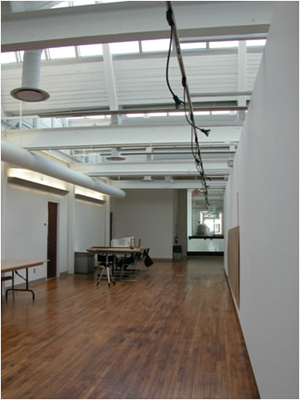
This loft at the School of Architecture at the University of Waterloo is fully lit by north facing skylights, yet the electric lights are on as they have been activated by a motion sensor. The intention was noble, but a light level sensor would have been more effective. This space could be 100% lit by natural light during the daylight hours. |
CARBON-NEUTRAL DAYLIGHTING STRATEGIES:
Sustainable and high-performance daylighting design strategies have been well-honed over the past decade and therefore this discussion will focus on the primary distinctions that can help to reduce or eliminate carbon emissions through daylighting design. While new carbon-neutral approaches to daylighting are still emerging, accepted design strategies from current zero- and low-carbon buildings include the following:
1. REDEFINE THE DAYLIGHTING PROGRAM: Strive for New Levels of Daylight Utilization
Despite a decade or more of advances in the integration of daylighting with increasingly efficient electric lighting systems, controls, and mechanical systems, natural light is still too often utilized as the secondary – rather than the primary – means of illumination. A great many buildings are still designed with (or restricted by) poor solar access, inadequate daylight strategies such as deep plans and sections, lack of effective electrical lighting integration or oversight, and little occupant education to promote resource-effective and ecological behaviors. Despite design and technological improvements, we find from one corner of the country to the other that few buildings truly optimize daylighting during daytime hours. While it is improbable - given cultural expectations, programmatic requirements, and diurnal and seasonal fluctuations - to eliminate electric lighting completely during the day, there is still great potential to reduce electric lighting loads more extensively when daylighting is more effectively integrated into the programming and design of architectural spaces.
For the greatest carbon and energy reductions, daylighting needs to be used as the primary means of illumination, not as a supplement to electric lighting. While this concept is consistent with current high-performance and sustainable design goals, the challenge of carbon-neutral daylighting is to more effectively shape the building form and integrate systems so that occupants and owners can literally “shut-off the lights,” while also reducing mechanical heating and cooling loads. Depending on the program and climatic variables, this degree of integration can be a significant design challenge. However, when successful, the solutions to these challenges are rewarded by the highest possible levels of ecological performance.
2. PRIORITIZE PASSIVE INTEGRATION: Consider a Multi-functional Approach
To foster carbon-neutrality, the daylight design must provide more than high quality illumination. It must also respond to a complex set of design issues and considerations from programmatic concerns to climatic response; energy, technology and systems integration; comfort, health and well-being; and aesthetic concerns, to name but a few. A “multi-functional” approach to daylighting considers how natural light can support diverse performance, ecological, and aesthetic design goals. We must reconsider how daylighting and passive solar design will be integrated in the twenty-first century.
The first consideration is to use the architecture itself to harvest energy. Without focusing on the architectural and ecological opportunities of passive design, it will be difficult, if not impossible, to reach low and zero-carbon and zero-energy goals. While formal, aesthetic, and expressive responses are as varied as are the individual architects and design firms, a common thread in low and zero-carbon architecture is a deep commitment by the design teams to harvest the sun, wind, and other sources of on-site renewable energy to light, heat, and cool the buildings. We also find an approach to daylighting and solar integration that draws on ancient lessons of passive and climate-responsive design that are coupled with state-of-the art technologies and new innovative approaches to high performance and responsive building envelopes. The daylighting design (from the scales of the building massing to the sectional design, envelope, apertures, solar control, and material finishes) must be thoughtfully and thoroughly integrated with the heating, cooling, and ventilation design and systems. A carbon-neutral approach to daylighting is likely to have an inherently thin profile that optimizes light and air; employs an ecological envelope that is responsive to the site and environmental forces; reduces or eliminates dependence on fossil fuels; is renewable; and strives for the consumption of little or no carbon-based energy.
Integrating Luminous and Thermal Criteria
To achieve carbon-neutrality, architect and daylighting expert Loren Abraham (AIA, LEED AP) of Loren Abraham Associates suggests that designers must consider new daylighting design questions that integrate luminous and thermal concerns: “How can daylighting really be made a priority? How can we raise the bar and achieve an 80% daylighting fraction savings? How can daylight be more integrated with passive heating and cooling? What functions and spaces can tolerate a greater diversity of illumination levels and changing qualities of daylight? Can more programmatically restrictive spaces be clustered together where electric lighting might be needed? How can we think differently? How can we eliminate electric all together? How can we redefine the program and what we are doing? What are different kinds of spaces and layout for the sun?” 2When designed to provide more than illumination, the daylighting section, window size, and envelope detailing will be skillfully oriented, sized, and detailed to meet both luminous and thermal criteria for lighting, solar control, heating, and/or ventilation based on climate and program. For example, in climates and programs with a dominate heating load, the window orientation and aperture sizing will often be determined by the thermal criteria rather than the luminous criteria (e.g. in cold climates the solar-oriented apertures will typically be larger if sized to meet the passive solar criteria than to meet average illumination levels). In contrast, in hot climates and programs with a dominant cooling load, the solution to reducing energy and related carbon emissions for cooling will typically be a full integration of daylighting and passive cooling strategies to minimize heat gain while optimizing airflow, natural ventilation, solar control, and indirect illumination. 2When designed to provide more than illumination, the daylighting section, window size, and envelope detailing will be skillfully oriented, sized, and detailed to meet both luminous and thermal criteria for lighting, solar control, heating, and/or ventilation based on climate and program. For example, in climates and programs with a dominate heating load, the window orientation and aperture sizing will often be determined by the thermal criteria rather than the luminous criteria (e.g. in cold climates the solar-oriented apertures will typically be larger if sized to meet the passive solar criteria than to meet average illumination levels). In contrast, in hot climates and programs with a dominant cooling load, the solution to reducing energy and related carbon emissions for cooling will typically be a full integration of daylighting and passive cooling strategies to minimize heat gain while optimizing airflow, natural ventilation, solar control, and indirect illumination.
Working with Sunlight
Designers will often need to work more effectively with direct sunlight to achieve carbon neutrality. For example, during the past decade, we have seen a movement – particularly in office and computer spaces - toward “cool daylighting,” which uses formal and technological strategies to provide indirect illumination and to control direct sunlight, glare, and heat gain. Yet, in a carbon-neutral approach to daylighting, particularly in cold or temperate climates during the heating season, designers may need to reconcile potential programmatic conflicts between the desires for luminous control and passive solar gains. Passive heating and cooling integration may lead to different solutions than would be sought if illumination were the only daylighting priority. With programs and activities that typically require control of sunlight, light levels, and glare, creative solutions will be needed that balance the desire for direct solar gain and the control of sunlight. A variety of simple strategies can support the integration of daylighting and passive solar design, including fresh approaches to luminous and thermal zoning, spatial planning, means of controlling direct sunlight within the space and/or at the location of the task, dynamic shading and solar control, innovative glazing technologies and systems, thermal night shading, as well as engaging occupant participation to foster more resource-effective behaviors. Depending upon the climate and program, design trade-offs and compromises may be needed to meet both the luminous and thermal priorities. Daylighting and passive integration should be carefully tailored to the specific luminous and thermal goals appropriate to climate and program. Designers should seek creative solutions that reduce carbon emissions and energy consumption while providing both high quality illumination and luminous and thermal comfort.
3. TAKE A MODEST APPROACH: Do More with Less
To achieve carbon-neutrality and reduce architecture’s ecological footprint, designers need to take a deeper look at energy and material consumption at all levels of design – including daylighting. The concept of a “modest architecture,” from the Latin “modestus - keeping due measure,” provides a means to seriously challenge how much GHG emissions, energy, and resource consumption is appropriate and ethical. The design professions simply can not continue to build spaces at the current rate, scale, and level of carbon emission and energy consumption. A serious investigation of a more “modest” approach to architectural design raises many daylighting design questions: What are the design opportunities of setting voluntary limits and working within a context of restraint? How can the theme of “modesty” help move daylighting design to a deeper level of sustainability? How might we approach the programming and goal setting-phases of daylighting design to go beyond resource efficiency to define more modest, even perhaps simple, solutions that are ecologically and programmatically appropriate? How might we use daylighting to “do more with less?”
The underlying theme of “doing more with less” can inspire a new understanding of the role and opportunities of daylighting design. In considering carbon-reducing design strategies, Bill Bordass of the Usable Building Trust in London explains the wisdom of modesty and simplicity: “We say: keep it simple, do it well, and only then be clever. Unfortunately, our POE [post-occupancy evaluation] work tells us that we often try to be clever before we get the basics right. So you find $1m [one million dollars] of PV on top of a 50,000 sq ft building reducing its carbon footprint by 10%, while you could have saved the same amount merely by ensuring the building was properly airtight and the heating was controlled better...Prevention is better than cure!” 3 While essentially uncharted design territory, a more modest and resource-effective approach to daylighting could influence all scales of design thinking. We most commonly think of daylighting as a means of providing energy-efficient illumination; however, it has far greater ecological potential when we explore ways that it can be coupled with other solar design strategies for heating and cooling and also to achieve ecological goals such as hot water heating, electricity generation, biological waste processing (e.g. living machines), and even food production. 3 While essentially uncharted design territory, a more modest and resource-effective approach to daylighting could influence all scales of design thinking. We most commonly think of daylighting as a means of providing energy-efficient illumination; however, it has far greater ecological potential when we explore ways that it can be coupled with other solar design strategies for heating and cooling and also to achieve ecological goals such as hot water heating, electricity generation, biological waste processing (e.g. living machines), and even food production.
To achieve new results, designers need to challenge basic premises of the programs, activities, and goals to question how much of any resource is really needed. With a carbon-neutral approach to design, we also go beyond energy and resource efficiency to use fewer resources: less space, less energy, less electricity, less resources, and less waste. Daylighting can be used in ingenious ways to serve multiple purposes that optimize passive strategies for lighting, heating, cooling, and natural ventilation, while at the same time fostering connections to the natural environment, providing views, celebrating diurnal and seasonal transitions as well as meeting other ecological agendas. Daylighting is a means to embody and reveal – through the physical attributes of the design - an ethic of responsible consumption. It demonstrates that the sun is a means to greatly reduce carbon emissions and energy consumption, while revealing that a modest design can be both beautiful and resource-effective. The challenge of carbon-neutral daylighting is to consider what role daylighting can play and how it can be combined with other tasks and issues. The integration of seemingly disparate issues requires innovation, experimentation, and a willingness to extend our thinking about the role of daylighting. While reductions in GHG emissions and the consumption of energy and natural resources inevitably result from doing more with less, this principle also challenges us to reconsider our patterns of consumption and personal values. To achieve new results, designers have to question the most basic premises of the daylighting program and goals and look anew at how daylighting can help us do more with less.
4. WORK WITH THE DYNAMICS OF DAYLIGHTING: Develop Diurnal & Seasonal Design Criteria
Architectural design can be tuned more finely to seasonally shifting luminous and thermal needs to further reduce energy consumption and related carbon emissions. The desired quality and quantity of light and need for solar access or control can change dramatically from morning to afternoon during a single day. To move toward carbon-neutrality, designers must consider how to work more effectively with the dynamic qualities, quantities, and character of daylight and its relationship to thermal design. While the changing colors, patterns, and character of daylight have captured the designer’s imagination throughout history, today’s architect faces a challenge that goes beyond merely celebrating the poetics of light to consider the aesthetic and the pragmatic design opportunities of seasonal daylighting. To develop seasonally-based design criteria, Loren Abraham suggests that: “We should be trying to achieve a target that is not a static illumination level. With technology we can have a static approach; but then we’re throwing the baby out with bathwater. The changing aspect of daylight is what makes daylight wonderful. The whole concept of daylighting buildings based on electric lighting standards as the gold standard is a shame. We have to look at lighting differently. All the standards are static. Is this really what we want? The trajectory should be to use different criteria per season. Change is good; so how do we meet the quality of light and yet have it be dynamic? We need a seasonal response.” 4 4
Rather than targeting a static daylighting design criteria for all times of the year, the design criteria might be developed on a seasonal and diurnal basis to address the distinct and changing luminous and thermal design conditions through time . A diurnal and seasonal matrix of pragmatic and poetic luminous and thermal design criteria and goals could be used to inform daylighting design decisions at different scales and across varied programs. Foremost is the importance of developing integrated luminous and thermal design criteria and goals that explicitly consider diurnal and seasonal flux: What luminous and thermal qualities are desired at different times of day and for differing seasons? How much light is needed at which times of the day and during which seasons? Can the daylighting be designed to provide occupant control and variability? What methods of interior and exterior solar control can be integrated with the daylighting to enable occupants to tune their luminous and thermal comfort to the particular season and time of day? How can the luminous and thermal designs celebrate the distinct seasonal qualities?
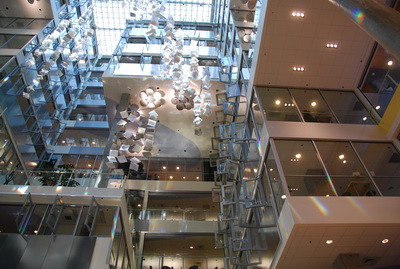
The atrium of the Genzyme Building in Boston uses natural light, aided by a series of reflectors to satisfy much of the light requirements of the core area of the office tower. |
5. USE RESPONSIVE ENVELOPES: Take a Layered Approach
In addition to the building form, section, and spatial configuration, the design of the building envelope is critical in reducing the carbon emissions. It is through the building skin that we can most directly foster a “dynamic” or diurnally and seasonally-responsive approach to the luminous and thermal design. The building envelope not only provides comfort and protection, it also shapes the character of our living spaces to inform our direct experience and aesthetic of the design. Many architects are looking at the building envelope as a key to reducing energy consumption throughout the lifetime of the building. As architects Michael Wigginton and Jude Harris explain: “The façade of a building can account for between 15% and 40% of the total building budget, and may be a significant contributor to the cost of up to 40% more through its impact on the cost of building services.” 5 The growing interest in using architecture as a means to respond to climate change is leading designers around the world to treat the envelope as a dynamic skin that can change with the seasons, adapt to the weather, and respond to the varying needs of the occupants. Thomas Herzog, an architect and professor at the Technical University in Munich, uses the metaphor of “living skin” to clarify the ecological role of the building envelope: “If we see the façade as the human body’s ‘third skin’ (after that of the body itself and our clothing), the analogy of the design objective becomes clear: the fluctuations of the external climatic conditions on our bodies have to be reduced by each of these functional layers in turn in order to guarantee a constant body temperature….” 5 The growing interest in using architecture as a means to respond to climate change is leading designers around the world to treat the envelope as a dynamic skin that can change with the seasons, adapt to the weather, and respond to the varying needs of the occupants. Thomas Herzog, an architect and professor at the Technical University in Munich, uses the metaphor of “living skin” to clarify the ecological role of the building envelope: “If we see the façade as the human body’s ‘third skin’ (after that of the body itself and our clothing), the analogy of the design objective becomes clear: the fluctuations of the external climatic conditions on our bodies have to be reduced by each of these functional layers in turn in order to guarantee a constant body temperature….” 6 For greater ecological responsiveness, Herzog recommends a multi-layered approach to the building envelope: “…the developments of recent decades, with the enormous increase in the requirements placed on the building envelope, have resulted in multiple layer constructions in which every single layer has to perform specific functions.” 6 For greater ecological responsiveness, Herzog recommends a multi-layered approach to the building envelope: “…the developments of recent decades, with the enormous increase in the requirements placed on the building envelope, have resulted in multiple layer constructions in which every single layer has to perform specific functions.” 7 7
The functions of the building envelope must be clearly defined in relation to specifics of time, climate, program, and users, as architect Werner Lang underscores in his essay “Is it All ‘Just’ a Façade”: “When the options for construction are taken into consideration as well, we are presented with a tremendous variety of different skin systems, which can be conceived in correspondence to the desired functional requirements. At the same time, one has a clear sense of the enormous creative freedom that results from using vastly different materials, surface structures, colours, formats, and propositions….the aim should be to develop a building skin that fully satisfies all the aspects relating to function, design and ecology. To this end, it is indispensable to establish a clear profile of the requirements, which the building skin must fulfill.” 8 When integrating passive and active solar, architects must balance daylighting, ventilation, passive heating, solar control, and renewable energy generation. Each of these considerations informs design decisions such as the orientation and size of apertures and the choice of interior and exterior materials, layers, and detailing. Depending on the climate and thermal loads, the size and placement of apertures, ventilation, and solar control can vary dramatically. Manfred Hegger, architect and professor at the Technical University of Darmstadt, emphasizes the complex dynamics of this approach to design: “The utilization of solar energy further expands the already complex functional spectrum of the envelope. The interface between interior and exterior must be understood as a dynamic system, which responds to the permanent variability in external radiation, climate conditions and internal requirements.” 8 When integrating passive and active solar, architects must balance daylighting, ventilation, passive heating, solar control, and renewable energy generation. Each of these considerations informs design decisions such as the orientation and size of apertures and the choice of interior and exterior materials, layers, and detailing. Depending on the climate and thermal loads, the size and placement of apertures, ventilation, and solar control can vary dramatically. Manfred Hegger, architect and professor at the Technical University of Darmstadt, emphasizes the complex dynamics of this approach to design: “The utilization of solar energy further expands the already complex functional spectrum of the envelope. The interface between interior and exterior must be understood as a dynamic system, which responds to the permanent variability in external radiation, climate conditions and internal requirements.” 9 9
A responsive building envelope also allows designers to accommodate the changing needs of users by giving them the ability to modify interior conditions during the day and as the seasons change. By adjusting interior and exterior layers, a responsive building envelope can be tuned to provide specific levels and qualities of daylighting, solar heating, shading, ventilation, views, and connections to site. These dynamic outcomes require a level of thoughtfulness and design integration that goes beyond technology, as architect Roland Krippner explains: “… [an] intelligent building is not necessarily just a matter of technical systems. The tremendous variety in regional approaches to building exemplifies what intelligent, that is, efficient, use of material and energy can be, because they combine rational thinking and craftsmanship with conclusive forms of expression. More technology is, clearly, not the only answer. Avoiding unnecessary technology, especially when it becomes an end in itself, can be just as innovative and intelligent.” 10 An adjustable envelope responds to environmental forces, internal loads, and varying luminous and thermal demands in much the same way as an organism responds to external and internal stimuli. The metaphor of the building “skin” as a biological entity is particularly helpful in reminding architects to think of “responding” to the changing environmental forces through design rather than by “controlling” the environment through technology. Regardless of the approach, manual or automated, low-tech or high, a “dynamic approach” to design criteria for daylighting, passive integration, and the building envelope is essential to reducing energy and carbon emissions. 10 An adjustable envelope responds to environmental forces, internal loads, and varying luminous and thermal demands in much the same way as an organism responds to external and internal stimuli. The metaphor of the building “skin” as a biological entity is particularly helpful in reminding architects to think of “responding” to the changing environmental forces through design rather than by “controlling” the environment through technology. Regardless of the approach, manual or automated, low-tech or high, a “dynamic approach” to design criteria for daylighting, passive integration, and the building envelope is essential to reducing energy and carbon emissions.
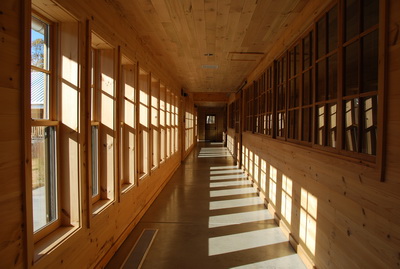
The Aldo Leopold Center uses this corridor to capture solar heat gain. The windows along the wall allow for the daylight to penetrate to light the offices, while at the same time reducing the effect of glare or overheating by virtue of the sill height selected for the inner windows. The outer window sill height was selected to maximize heat gain. |
6. DEEPEN TECHNOLOGY AND SYSTEMS INTEGRATION: Take a Hybrid-Solar Approach
To achieve carbon-neutrality, designers need to integrate daylighting fully with passive and active design strategies, innovative mechanical and electrical systems, new envelope technologies, and renewable energy. Architect Christian Schittich emphasizes the need for an integrated approach to daylighting and solar design: “…solar architecture cannot be reduced to isolated measures such as collectors or photovoltaic installations on the roof. Rather, a building must be understood as a complex configuration – a total energy concept – that makes the best possible use of locally available natural resources such as solar energy, wind and geothermal energy for a variety of requirements. Passive and active measures complement one another in this approach, from the orientation and division of the building to the integration of systems for the generation of warm water or power. Flexible envelopes, regulated by intelligent control systems and capable of reacting to varying influences and weather conditions are making increasingly important contributions….” 11 11
A “hybrid solar approach” suggests that architectural design can simultaneously reduce carbon emissions while helping to meet the energy needs of the building and perhaps the community and the world beyond. As Manfred Heggar explains in his essay “From Passive Utilization to Smart Solar Architecture” a new approach to daylighting and passive design integration is a key to energy and carbon reduction: “…this will be the path to sustainable, energy-efficient solar architecture. It begins with passive solar use, is easy to implement and is reliable…It is controllable through intelligent, self-regulating control technologies – smart control. Finally it combines passive and active solar systems….Keywords in this field are hybrid solar systems, micro-climatic building skins and self-regulating facades. The development of smart solar architecture will give rise to new technologies, and to an eagerly anticipated new architecture.” 12 12
This “hybrid approach” to daylighting and solar design is found in leading examples of low and carbon-neutral architecture around the world. While in some cases introducing a new level of complexity, this holistic concept may provide a key to unlock new levels of sustainable design performance, including greater reductions in carbon emissions and energy consumption. This deeply systemic approach may even move design beyond carbon-neutrality and net-zero energy targets to create an architecture that actually produces rather than consumes energy. New and emerging solar architecture suggests that designers will find seemingly unlimited formal, stylistic, and expressive design opportunities through a hybrid approach to integrated daylighting and solar design. The need for sophisticated systems integration challenges design teams to further collaborate across areas of design expertise and to more rigorously investigate methods of design assessment and analysis.
7. CELEBRATE THE POETICS OF LIGHT: Integrate Qualitative & Quantitative Considerations
The poetics of light is perhaps the primary reason that architects have been fascinated with daylighting design throughout history. With carbon-neutral design, we should look even more closely at the relationship between poetic and pragmatic design criteria to consider not only how to foster deeper ecological design performance, but also to celebrate the beauty of natural light. The integration of poetic and pragmatic considerations is a distinguishing feature of the most innovative and elegant design approaches to zero energy and carbon-neutral architecture; revealing that it is possible to respond to urgent ecological challenges while also fostering design excellence. Architect Lawrence Scarpa, of Pugh+Scarpa Architects, emphasized in an interview that aesthetic issues and the importance of good design should not be underestimated: “An energy hog is better than an energy efficient building that no one loves. Don’t worry about ‘sustainable design,’ focus on design.” 13 Yet, given the urgency of current ecological concerns, why do aesthetics and beauty matter? The answer, as Scarpa suggests, is that people will be more likely to seek out, accept, and care for sustainable architecture when they love the design of the building. Aesthetics, beauty, human experience, health, and well-being are just as important as are a building’s greenhouse gas emissions, carbon reductions, ecological footprint, and energy profile. 13 Yet, given the urgency of current ecological concerns, why do aesthetics and beauty matter? The answer, as Scarpa suggests, is that people will be more likely to seek out, accept, and care for sustainable architecture when they love the design of the building. Aesthetics, beauty, human experience, health, and well-being are just as important as are a building’s greenhouse gas emissions, carbon reductions, ecological footprint, and energy profile.
Is there a carbon-neutral design aesthetic and sense of beauty? Can architecture embody design excellence if it produces greenhouse gas emissions, consumes large quantities of natural resources, creates pollution and waste, and directly or indirectly leads to the destruction of habitat? To realize its full potential, sustainable architecture must embody a deeper ecological aesthetic and ethos. The forces of sun, wind, and site provide aesthetic opportunities that shape the architectural language and expression of the building form and envelope. In addition, new materials and components are further expanding the architect’s daylighting design palette, as editor Frank Kaltenbach explains: “… now architects, and interior and other designers, have new building materials at their disposal, ranging from completely transparent to almost opaquely translucent. These products do not just meet increasingly complex requirements and regulations, but provide a design potential that is still far from exhausted….Functions like solar screening, glare protection, sight-screening or creative requirements can be fulfilled by membranes or perforated metal sheeting. Composite products, exploiting the positive properties of several materials, are also becoming more common.” 14 While the aesthetic expression of carbon-neutral daylighting is yet emerging; recent low-energy and low-carbon buildings suggest that its design potential is limited only by the designer’s imagination. 14 While the aesthetic expression of carbon-neutral daylighting is yet emerging; recent low-energy and low-carbon buildings suggest that its design potential is limited only by the designer’s imagination.
Most architects are aware of the varied design tools used to make quantative assessments of daylighting and thermal design, but fewer may appreciate the importance of also conducting qualitative daylighting assessments. The selection of assessement and analysis methods should consider both the pragmatic and poetic dimensions of daylighting and its integration with thermal design and energy systems. Despite the fairly common use of daylighting computer software such as Radiance, ECOTECT, and DAYSIM, as well as more advanced energy programs such as EnergyPlus, Energy-10, eQUEST, and DOE-2, architects should not underestimate the importance of simple physical models. Diurnal and seasonal photographic studies of physical daylighting and envelope models are invaluable for qualitative design assessment and are a critical complement to quantitative computer analysis. While sophisticated computer renderings of interior spaces can be a valuable qualitative design tool, two-dimensional renderings still cannot rival the level of visual understanding that can be gained by even simple physical study models, which can be used to iteratively test and compare varied daylighting design strategies, materials, envelopes, and shading systems. The design understanding gained through direct visual observation of a three-dimensional model when combined with computer studies enables designers to more effectively integrate the pragmatic performance criteria with the poetics of daylighting design.
Reference Study: Lavin-Bernick Center for University Life
Location: New Orleans, LA
Architect: VJAA
Winner 2008 AIA/COTE Top Ten Green Projects
Photographer: Terri Meyer Boake, University of Waterloo
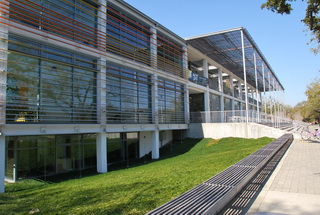 |
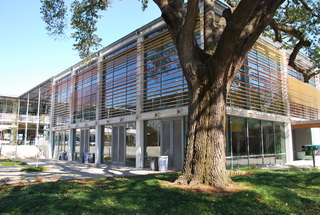 |
| North façade (left): |
Corner detail of West/South façade (right): |
Daylighting, natural ventilation, and solar control are integrated at multiple scales, from the building massing and section to the envelope details.
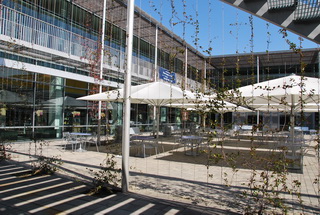 |
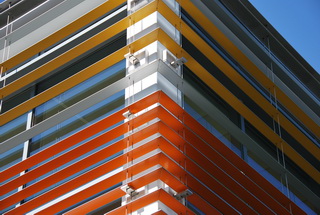 |
| Courtyard and garden spaces (left): |
Corner detail of West/South façade (right): |
Three-dimensional approach to the building envelope, including exterior overhangs, horizontal shading, vertical vegetation, high performance glazing, and interior solar control. Operable doors with screens can be opened to extend the interior into the courtyard and garden spaces.
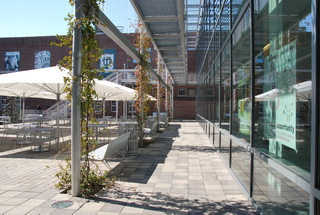 |
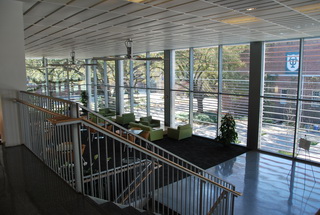 |
| Exterior of the west façade (left): |
Interior view of the west façade (right): |
Exterior and interior details of the west façade illustrating the integration of design strategies for daylighting, natural ventilation, and solar control. There is a vertical and horizontal layering of light and solar control in the courtyard, gardens, balconies, and interior rooms.
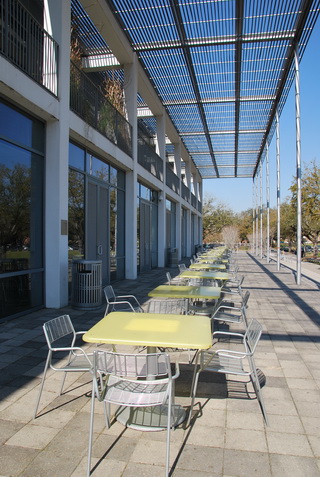 |
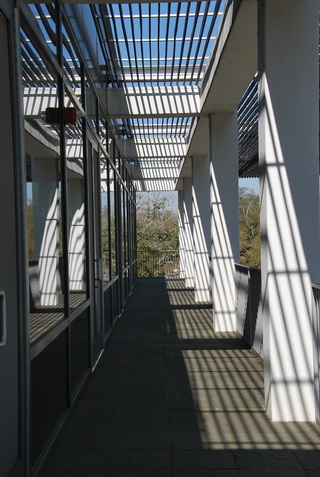 |
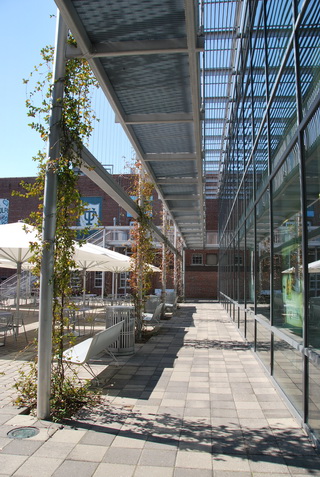 |
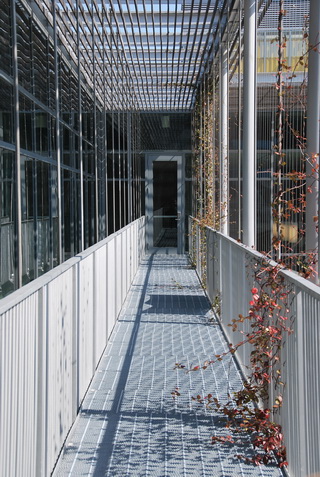 |
| Courtyard envelope details |
Exterior envelope details illustrating the varied luminous and thermal qualities of exterior spaces.
Note: An extensive list of design tools and daylighting, passive solar, and envelope resources are provided through the “CND Resource and Links.”
HELPFUL LINKS IN THE AIA 50to50 WIKI:
Daylighting
Open, Active, Daylit Spaces
Sun Shading
Other Helpful Links:
The Square One Website Archive has some very good instructional information on Lighting Design, Illumination and
Daylighting.
http://www.squ1.com/archive/
Whole Building Design Guide: Daylighting
http://www.wbdg.org/resources/daylighting.php
The Daylighting Guide for Canadian Commercial Buildings:
http://www.enermodal.com/Canadian/pdf/DaylightingGuideforCanadianBuildingsFinal6.pdf
Daylighting: Ecotect WIKI
http://squ1.org/wiki/Daylighting
Tips for Daylighting: Lawrence Berkeley Labs
http://www.architecture.uwaterloo.ca/faculty_projects/terri/powerpoint/daylighting_guide.pdf
HIGHLY RECOMMENDED TEXTS FOR DAYLIGHTING (written by SBSE members!):
Daylighting for Sustainable Design. Mary Guzowski.
Green Studio Handbook: Environmental Strategies for Schematic Design. Alison Kwok and Walter Grondzik.
Heating, Cooling, Lighting: Sustainable Design Methods for Architects. Third Edition. Norbert Lechner.
Mechanical and Electrical Equipment for Buildings. Benjamin Stein, John Reynolds, Walter Grondzik, Alison Kwok.
Sun, Wind and Light: Architectural Design Strategies. Second Edition. G. Z. Brown and Mark DeKay.
OTHER RESOURCE MATERIALS:
Books and Articles: Daylighting
- Ander, Gregg. Daylighting, Performance and Design, New York: Van Nostrand Reinhold, 1995.
- Baker, Nick and Koen Steemers. Daylight Design of Buildings. London: James and James 2002.
- Baker, N.V., A. Fanchiotti, and K. Steemers, editors. Daylighting in Architecture: A European Reference Book. London: James & James, 2001.
- Deutsches Architektur Museum, editor. The Secret of the Shadow: Light and Shadow in Architecture. Germany: DAM, 2002.
- Egan, David and Victor Olgyay. Daylight in Buildings. International Energy Agency, 2000. Architectural Lighting, Second Edition. McGraw Hill, 2nd Ed, 2002.
- Gannon, Todd, editor. The Light Construction Reader. New York: The Monacelli Press, 2002.
- Guzowski, Mary. Daylighting for Sustainable Design. New York: McGraw-Hill, 2000.
- Herzog, Krippner, and Lang. Façade Construction Manual, Basel: Birkhäuser Publishers, 2004.
- Illuminating Engineering Society of North America (IESNA). The IESNA Lighting Handbook, New York: IESNA, 2000.
- Meyers, Victoria. Designing with Light. New York: Abbeville Press Publishers, 2006.
- Millet, Marietta. Light Revealing Architecture. New York: Van Nostrand Reinhold, 1996.
- Phillips, Derek. Daylighting: Natural Light in Architecture, Architectural Press, 2004.
- Richards, Brent. New Glass Architecture. New Haven: Yale University Press, 2006.
- Robbins, Claude. Daylighting Design and Analysis, New York: Van Nostrand Reinhold, 1986.
- Schittich, Christian, editor. inDETAIL: Solar Architecture. Basel: Birkhäuser Publishers, 2003.
- Klaus Daniels, Low-tech Light-tech High-tech, Basel: Birkhauser, 2000.
Online Resources: Daylighting
- Archi-Physics Solar Tools, www.archiphysics.com
- City of Boulder. (2006). Solar Access Guide, Building Services Center, Boulder, Colorado http://joomla.ci.boulder.co.us/files/PDS/codes/solrshad.pdf
- Commercial Windows for High Performance Buildings, www.commercialwindows.umn.edu
- Daylighting Collaborative, www.daylighting.org
- Department of Energy, www.eere.energy.gov/buildings/info/design/integratedbuilding/passivedaylighting.html
- DAYSIM, Getting Started, McGill University, http://www.arch.mcgill.ca/prof/reinhart/software/GettingStarted.pdf
- ECOTECT, Autodesk, 2009, http://www.ecotect.com
- Efficient Windows Collaborative, http://www.efficientwindows.org/
- Glass Resources, www.glass-resource.com
- Heschong Mahone Group, www.h-m-g.com
- Home Energy Efficient Design (HEED), http://mackintosh.aud.ucla.edu/heed/
- Insulating Glass Manufacturers Association, www.igmaonline.com
- International Solar Energy Society, www.ises.org
- Lawrence Berkeley Laboratory, Tips for Daylighting with Windows, www.lbl.gov
- Lighting Research Center, www.lrc.rpi.edu
- Lighting Research Center, Guide for Daylighting Schools, Innovative Design, 2004, www.lrc.rpi.edu
- National Fenestration Rating Council, www.nfrc.org
- Natural Resources Canada, Daylighting Guide for Canadian Commercial Buildings, www.advancedbuildings.org
- Reinhart, C., Advanced Daylight Simulation using ECOTECT, Radiance, Autodesk, 2009, Autodesk ECOTECT Wiki, http://squ1.org/front_.
- U.S. Department of Energy, 2009, Energy Plus Weather Data, http://apps1.eere.energy.gov/buildings/energyplus/cfm/r_data.cfm
- U.S. Department of Energy (DOE) Sponsored Tools (from the U.S. DOE Website), http://apps1.eere.energy.gov/buildings/tools_directory/doe_sponsored.cfm
REFERENCES:
2 Loren Abraham, Abraham and Associates, interview with author, May 14, 2009.
3 Bill Bordass, Society of Building Science Educators Listserver, December 4, 2008.
4 Loren Abraham, Abraham and Associates, interview with author, May 14, 2009.
5 Michael Wigginton and Jude Harris, 3.
6 Thomas Herzog, Roland Krippner, and Werner Lang, Façade Construction Manual (Munich: Birkhäuser, 2004), 19.
8 Werner Lang, “Is it All ‘Just” a Façade:The Functional, Energetic and Structural Aspects of the Building Skin,” Building Skins: Concepts Layers Materials, edited by Christian Schittich (Basel: Birkhäuser, 2001), 44.
9 Manfred Hegger, “From Passive Utilization to Smart Solar Architecture,” Solar Architecture, edited by Christian Schittich (Basel: Birkhäuser, 2003), 19.
11 Christian Schittich, “Shell, Skin, Materials,” Building Skins: Concepts Layers Materials (Basel: Birkhäuser, 2001), 9.
12 Manfred Hegger, “From Passive Utilization to Smart Solar Architecture,” Solar Architecture, edited by Christian Schittich (Basel: Birkhäuser, 2003), 24.
13 Laurence Scarpa, Pugh+Scarpa Architects, interview with author, July 18, 2008.
14 Frank Kaltenbach, ed., Translucent Materials: Glass Plastic Metals (Basel: Birkhäuser, 2004), 7.

HELPFUL LINKS IN THE AIA 50to50 WIKI:
Daylighting
Open, Active, Daylit Spaces
Sun Shading
Other Helpful Links:
The Square One Website Archive has some very good instructional information on Lighting Design, Illumination and Daylighting.
http://www.squ1.com/archive/
Whole Building Design Guide: Daylighting
http://www.wbdg.org/resources/daylighting.php
The Daylighting Guide for Canadian Commercial Buildings:
http://www.enermodal.com/Canadian/pdf/DaylightingGuideforCanadianBuildingsFinal6.pdf
Daylighting: Ecotect WIKI
http://squ1.org/wiki/Daylighting
Tips for Daylighting: Lawrence Berkeley Labs
http://www.architecture.uwaterloo.ca/faculty_projects/terri/powerpoint/daylighting_guide.pdf
HIGHLY RECOMMENDED TEXTS FOR DAYLIGHTING (written by SBSE members!):
Daylighting for Sustainable Design. Mary Guzowski.
Heating, Cooling, Lighting: Sustainable Design Methods for Architects. Third Edition. Norbert Lechner.
Mechanical and Electrical Equipment for Buildings. Benjamin Stein, John Reynolds, Walter Grondzik, Alison Kwok.
Sun, Wind and Light: Architectural Design Strategies. Second Edition. G. Z. Brown and Mark DeKay.
The Green Studio Handbook: Environmental Strategies for Schematic Design. Walter Grondzik and Alison Kwok.
|

